Behavioral SEO & Engagement Optimization
Aligning Content Strategy with Search Intent and User Behavior

Ranking in search results is no longer determined solely by keyword usage — it's influenced by how well your content matches the user’s underlying intent and behavioral patterns. Behavioral SEO is a modern, data-informed approach that aligns your content strategy with how users actually search, click, scroll, and engage. It recognizes that satisfying the search engine algorithm is only part of the equation — delivering a seamless, relevant experience for human visitors is equally important.
Understanding search intent — whether informational, navigational, transactional, or comparative — is the starting point. Users arriving at your content have specific goals, and if your page fails to meet those expectations quickly and clearly, they'll bounce. By crafting articles that directly address those goals with clarity and purpose, you increase the likelihood of both higher rankings and deeper engagement.
Modern search behavior is also increasingly shaped by device type, context, and user expectations. For example, a mobile user scanning on the go will interact differently than a desktop researcher conducting a deep dive. Aligning your layout, content structure, and visual hierarchy to support these differences improves time on page, reduces friction, and supports stronger behavioral signals — all of which factor into SEO performance.

To elevate your SEO content optimization strategy, consider leveraging AI tools that analyze engagement metrics like heatmaps, scroll depth, and interaction hotspots. These insights reveal where users lose interest or encounter barriers, allowing you to make targeted improvements. Even simple adjustments — such as reordering sections based on click patterns or embedding scannable summaries — can lead to significant improvements in dwell time and content consumption.
Behavioral SEO ultimately encourages you to think beyond search engine mechanics and design content that delivers real value. Prioritize clarity, user experience, and intuitive navigation, and your content will not only earn visibility but also build trust, retain attention, and drive repeat engagement — the signals that both people and algorithms reward.
What Is Behavioral SEO?

Behavioral SEO is the practice of optimizing content not just for search engines, but for how users actually interact with your website. It involves analyzing and responding to behavioral signals such as bounce rate, average session duration, scroll depth, and internal click activity. These signals give search engines real-time feedback on whether your content satisfies the needs of the user — and whether it deserves to rank higher in the results.
Unlike traditional SEO, which often focuses on keywords, backlinks, and metadata, behavioral SEO shifts attention to user engagement and satisfaction. For example, if a user clicks through from a search result but quickly leaves, it signals a disconnect between your content and their expectations. Conversely, when visitors stay longer, scroll deeper, and interact with related pages, it shows the content is relevant, helpful, and worth promoting in search rankings.
To understand the value of behavioral SEO, consider how search engines like Google evaluate content quality today. They no longer rely solely on technical signals — they interpret behavioral data to assess the user experience. If your content performs well with real users, it’s far more likely to perform well in the rankings. This means your optimization efforts must account for how people consume and react to your content — not just how it’s structured for bots.

Many digital teams now use tools like SEOBoostAI, Hotjar, and Google Analytics to gather behavioral insights. These tools can show you exactly where users drop off, which sections draw the most attention, and how engagement varies across devices. For example, if heatmaps reveal that mobile users are skipping large blocks of text, you can revise your layout and copy to support faster, more intuitive scanning — a key aspect of effective SEO content optimization.
Behavioral SEO also supports your broader content SEO strategy by encouraging intentional, user-driven improvements. Instead of guessing what might work, you make data-backed adjustments that align with user preferences. This could mean simplifying navigation, improving internal linking, or reordering sections to match reading flow. Over time, these iterative enhancements compound, leading to better rankings, higher retention, and stronger conversion rates.
In essence, behavioral SEO is about building a feedback loop between your audience and your content. Paying attention to what users do — not just what they search — unlocks new opportunities to refine your site, improve satisfaction, and outperform competitors who rely solely on traditional tactics. It’s a future-forward strategy designed for the evolving expectations of both algorithms and humans.
Why Behavioral SEO Matters for Rankings and Engagement

Search engines like Google are increasingly focused on how users behave after they click a search result — not just whether the content contains the right keywords. Behavioral SEO plays a central role in helping content rank well and stay competitive by signaling that your page provides value, answers the query, and encourages further exploration. These behavioral cues help search algorithms distinguish between optimized content and content that’s actually helpful.
Key engagement metrics — including dwell time, bounce rate, scroll depth, and internal click-throughs — now serve as performance validators. When these indicators are strong, it tells search engines your content is both relevant and useful. If visitors land on a page and immediately bounce, it suggests a disconnect between the user’s intent and the content delivered. Over time, this can lead to ranking declines, even if technical SEO is sound.
Behavioral SEO strengthens your content SEO strategy by shifting the focus from static optimization to continuous improvement. For example, if analytics show that most users exit after the first paragraph, you may need to rewrite your introduction to better align with search intent. Similarly, if heatmaps reveal that users aren’t reaching key conversion sections, restructuring the layout for visibility can significantly improve engagement and goal completion rates.
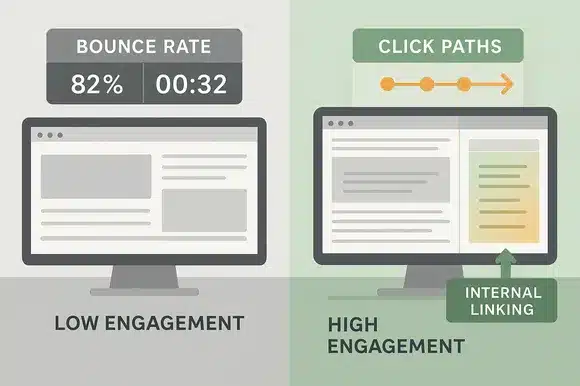
These user signals are also interpreted as trust indicators. Content that holds attention, invites interaction, and prompts return visits tends to rank higher and convert better. This creates a feedback loop: engaged users help improve visibility, and increased visibility drives more engagement. Pages that outperform on behavioral metrics often become long-term traffic assets because they meet the dual goals of discoverability and usability.
The benefits also extend beyond rankings. Engagement-driven content supports business outcomes like lead generation, brand loyalty, and conversion. For example, an article that encourages users to scroll and explore internal links naturally leads to more time on site — a key factor in behavioral performance — while also nurturing them down the marketing funnel. This is where behavioral SEO and ROI begin to intersect, especially when paired with strategic internal linking and well-placed CTAs.
To succeed, brands must consistently monitor engagement metrics and use them to refine content over time. Tools like SEOBoostAI, Google Analytics 4, and Microsoft Clarity allow marketers to visualize how users interact with their content and identify friction points. Rather than optimizing once and forgetting it, behavioral SEO encourages a living content approach — where performance evolves based on how users actually behave.
In a competitive digital landscape, content that simply ranks isn’t enough. Behavioral SEO ensures that your content not only earns attention but deserves it — by focusing on the experience users have once they land on your page. It turns engagement into a measurable asset and elevates SEO from a checkbox to a strategic advantage.
How to Apply Behavioral SEO: A Step-by-Step Strategy

Applying behavioral SEO requires more than checking off traditional optimization boxes — it demands a content strategy built around real human behavior. By structuring your content around how users think, browse, and decide, you improve both your search visibility and on-page performance. This step-by-step strategy outlines how to build behavior-first content that earns clicks, encourages deeper engagement, and improves ranking signals across the board.
Step 1: Start with Search Intent
Search engines reward content that solves the user’s actual need — not just content that matches a phrase. Begin every project by identifying what the user hopes to accomplish. Are they researching, comparing, or preparing to take action? Use SERP features like People Also Ask, autosuggest, and related searches to map intent tiers. Then, format your article accordingly — for example, use quick answers and summaries if the user wants fast facts, or detailed step-by-step content for how-to intent. This alignment helps lower bounce rates and raises content relevance in behavioral SEO models.
Step 2: Structure for Scannability
Online readers typically scan before they commit. To support that behavior, break content into smaller sections using clear headings, short paragraphs, and formatting cues like callouts or numbered steps. Make the path through your article obvious and easy to follow. For example, adding bolded transition phrases like “Here’s what to do next” can help orient distracted readers and encourage continued engagement. Scannability directly supports positive behavioral signals like increased scroll depth and time on page.
Step 3: Use Engaging Visuals
Visuals help simplify complex ideas and prevent content fatigue. Include high-quality images, charts, diagrams, or annotated screenshots that reinforce key points. Effective visuals encourage users to pause, absorb, and stay engaged longer, especially on mobile where large blocks of text can feel overwhelming. Use descriptive alt text and captions to enhance accessibility and SEO value. For example, pairing a step-by-step explanation with a labeled diagram can significantly boost comprehension and reduce bounce.
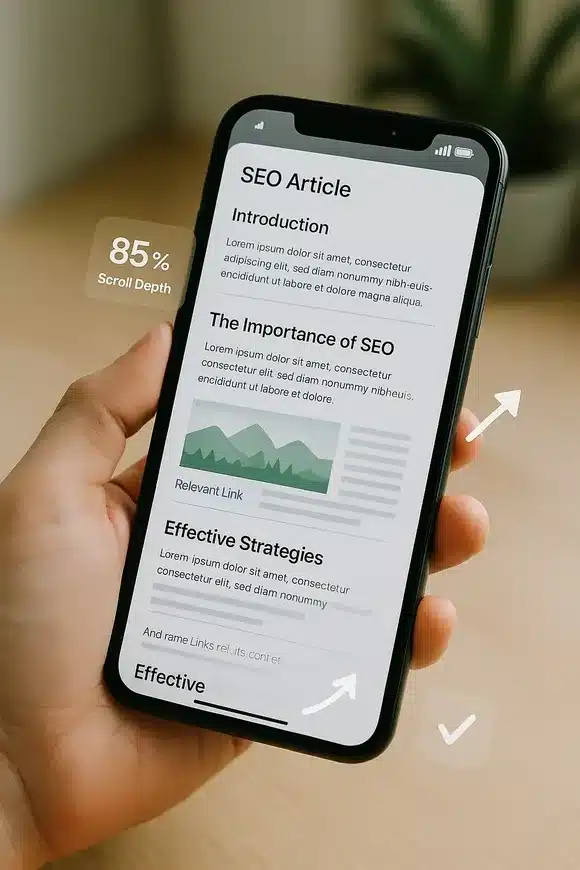
Step 4: Optimize Internal Navigation
A strong internal linking structure encourages users to explore related content and stay on your site longer — both essential behavioral SEO signals. Use anchor text that matches the user’s next likely question or action, and guide them through a logical content journey. For example, link a page about behavioral SEO best practices to a related guide on user engagement analytics. This keeps sessions active, supports crawl depth, and distributes SEO value across your domain more effectively.
Step 5: Monitor and Adjust
Behavioral SEO is iterative. After publishing, use tools like Google Analytics 4, SEOBoostAI, or Hotjar to track behavior metrics such as exit points, scroll maps, and CTA interaction. Identify where users are stalling, skimming, or dropping off — then test improvements based on real usage patterns. Even minor changes, like rewriting a headline or repositioning a key image, can lead to measurable gains in engagement and ranking stability. Regular analysis ensures your content continues to evolve with shifting user expectations and algorithm changes.
By following these five steps, you create content that not only attracts traffic but also drives the behavioral signals that influence modern SEO success. It’s a sustainable, scalable way to build user trust while aligning with how search engines reward engagement.
Best Practices and Common Mistakes in Behavioral SEO

Behavioral SEO thrives on relevance, clarity, and intentional user experience. While technical SEO creates the foundation, it’s behavioral signals that influence long-term content performance. The strategies that earn clicks and retain attention aren’t complicated — but they require focus, consistency, and user-centered design. The following best practices and mistakes will help you avoid friction points and reinforce content that ranks and converts.
Best Practice #1: Prioritize User Experience Over Keywords
Yes, keywords matter — but forcing them disrupts readability. Instead, build your content around clear answers, intuitive structure, and user-friendly tone. Use natural phrasing, anticipate follow-up questions, and provide actionable insight. When users feel like your page “gets them,” they stay longer and interact more — generating the exact behavioral signals search engines track.
Best Practice #2: Keep Pages Visually and Functionally Clean
A clean interface helps users focus. Use white space to separate ideas, limit font variations, and avoid cluttered sidebars or pop-up overload. Design with accessibility in mind — including legible text sizes, mobile-friendly formatting, and responsive media placement. When your page feels organized and inviting, users are more likely to engage, scroll deeper, and revisit your site.
Best Practice #3: Use Data to Drive Decisions
Don’t assume what users want — analyze how they behave. Use behavior tracking tools to uncover where attention drops, where scroll depth flattens, or where bounce rates spike. Let metrics inform your content updates, visual hierarchy, and navigation structure. For example, if most users never reach your CTA, move it higher or embed it earlier in the reading path.
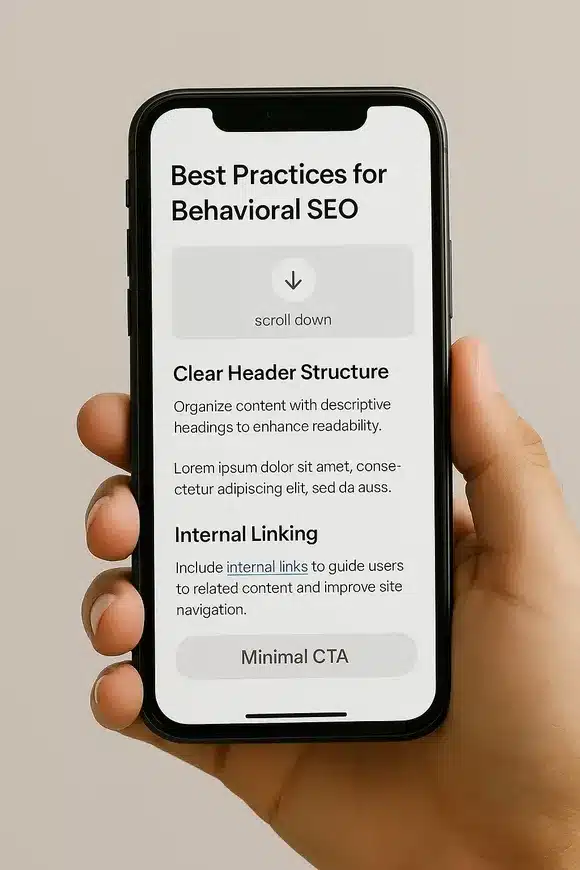
Best Practice #4: Encourage Micro-Engagement
Small user actions create big behavioral impact. Add subtle prompts like expandable FAQs, scroll-triggered animations, or contextual link cards. These touches extend session time and signal active interest. Even minor additions — such as a related content block or a user-friendly filter — can increase dwell time without overwhelming the experience.
Common Mistake #1: Ignoring Mobile Behavior Patterns
Many pages still favor desktop-first layout choices, which alienate mobile users. Mobile audiences tend to scan more rapidly, tap instead of click, and bounce quickly from hard-to-navigate designs. Optimize vertical spacing, make CTAs thumb-friendly, and avoid forcing pinch-to-zoom interactions. Behavior-based SEO starts with delivering a frictionless experience on the devices users prefer.
Common Mistake #2: Overusing CTAs or Pop-Ups
Aggressive CTAs can backfire. If users feel rushed or bombarded, they’ll leave — and that bounce negatively impacts behavioral SEO. Instead of pushing actions too early, offer CTAs after you’ve delivered value. For example, placing a sign-up form after a helpful tip list feels natural, while one that appears before the content loads feels disruptive and pushy.
Common Mistake #3: Treating All Content the Same
A one-size-fits-all approach is a shortcut to underperformance. Content designed for product comparison should not mimic blog tutorials or brand storytelling formats. Tailor structure and tone based on content type, funnel stage, and expected engagement depth. This ensures every asset delivers the right experience — which improves retention, interaction, and SEO outcomes.
Conclusion: Build SEO That Works With — Not Against — User Behavior
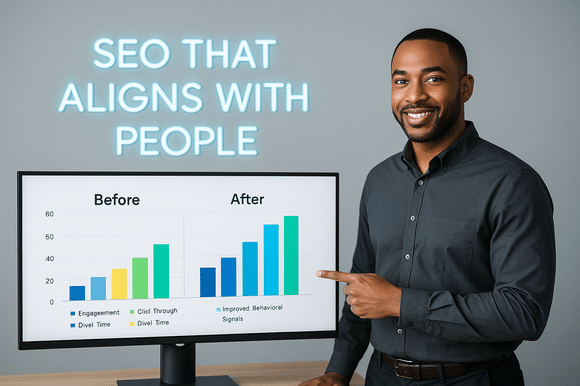
SEO has evolved — and so have the expectations of your audience. Success today isn’t measured by ranking alone, but by what happens after the click. Behavioral SEO places the user at the center of your strategy, aligning every content decision with how real people search, interact, and evaluate digital experiences. It turns traditional optimization into a dynamic feedback loop — one that rewards quality, relevance, and usability.
Search engines like Google increasingly rely on behavioral indicators — such as dwell time, scroll activity, bounce rate, and link engagement — to evaluate content quality. Pages that meet the user’s intent and encourage further exploration rise in visibility over time, while those that fail to deliver value lose traction. This makes behavior a critical success factor for content marketers, SEOs, and business owners alike.
Optimizing for behavioral signals doesn’t mean abandoning keyword strategy — it means amplifying it through intentional experience design. When your content is clear, helpful, well-structured, and visually supportive, users stay longer, engage more deeply, and are more likely to take meaningful action. This engagement builds trust, strengthens authority, and reinforces positive ranking momentum.
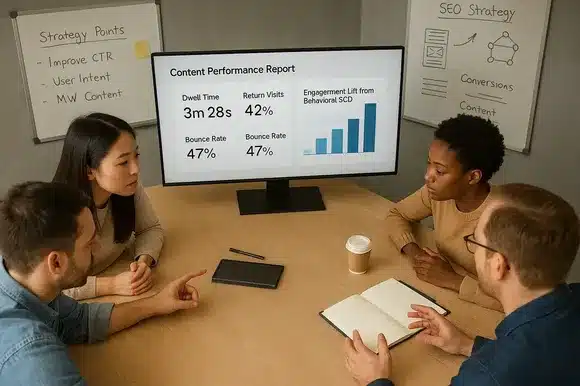
The intersection of SEO content optimization and user behavior is where sustainable results are born. Whether you're publishing a blog post, product page, or lead-generation asset, aligning your strategy with how users behave creates measurable performance improvements — not just in traffic, but in retention, conversion, and lifetime value. And with tools like SEOBoostAI, even complex behavior tracking becomes scalable and actionable.
Ultimately, behavioral SEO encourages you to stop optimizing *at* your audience and start optimizing *for* them. Every search is a question. Every click is a decision. And every behavior is a signal. When your content is built to serve real people — not just rank in abstract — you create momentum that algorithms reward and audiences remember.
Want to put these principles into action? SEOBoostAI gives you the tools to align your SEO strategy with real-time user behavior — from search intent mapping to performance tracking and guided content structuring. Let’s talk about how behavioral SEO can reshape your content results and grow your digital presence.
Frequently Asked Questions

What is behavioral SEO and how does it work?
Behavioral SEO is the practice of optimizing your content based on how users interact with it — not just the keywords it contains. It focuses on engagement signals like bounce rate, scroll depth, and click-through patterns to evaluate content quality. Pages that retain users and prompt further interaction tend to be rewarded with higher rankings, as search engines interpret those actions as signs of value and relevance.
Why is user behavior important for SEO?
Search engines increasingly use behavioral signals to assess whether content satisfies user expectations. If visitors stay longer, engage with your layout, or click through to related resources, those interactions signal relevance. This behavioral validation supports ranking stability, improves SEO performance, and often correlates with stronger conversion rates.
How can I track behavioral SEO performance?
Behavioral performance can be tracked using tools like Google Analytics 4, Microsoft Clarity, or Hotjar. These platforms provide insights into metrics such as session duration, page scroll depth, and heatmaps. Reviewing this data helps identify high-exit areas, low-engagement sections, and opportunities to improve user experience and content flow.
Does optimizing for behavior mean I should ignore keywords?
No — keywords remain essential for visibility. Behavioral SEO works alongside traditional strategies by ensuring that once users arrive, they stay and engage. The goal is to balance keyword targeting with user satisfaction — so content is both findable and effective.
What are the most common behavioral SEO mistakes to avoid?
Frequent mistakes include ignoring mobile usability, overloading pages with aggressive CTAs, using unscannable layouts, and treating all content types the same. To avoid these issues, SEOBoostAI will tailor your formatting, structure, and navigation to reflect the intent and behavior patterns of your specific audience.